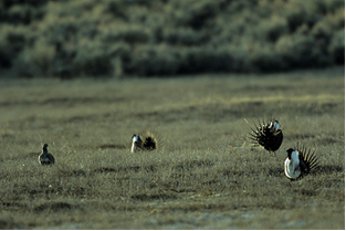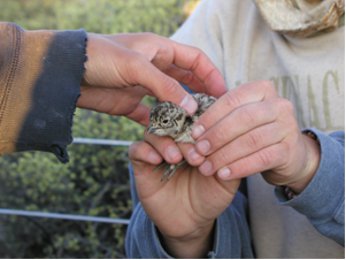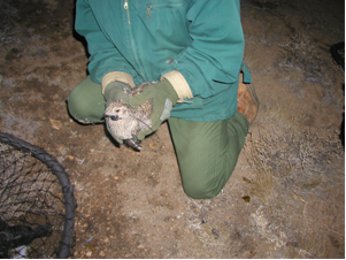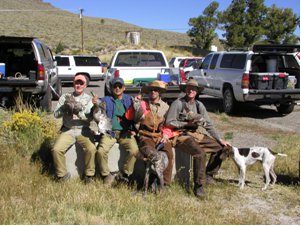Lead CDFW biologist: Tim Taylor
 Sage grouse lek. Photo by Art Lawrence
Sage grouse lek. Photo by Art Lawrence
 Captured sage grouse chick.
Captured sage grouse chick.
 Hen sage grouse with radio-collar.
Hen sage grouse with radio-collar.
 Successful sage grouse hunters in Long Valley.
Successful sage grouse hunters in Long Valley.
On March 5, 2010, the U.S. Fish and Wildlife Service determined that greater sage-grouse (Centrocersus urophasianus) were warranted for listing under the Endangered Species Act (ESA), but currently precluded by the need to first list higher priority species. Furthermore, the U.S. Fish and Wildlife Service determined that the Bi-State population of greater sage-grouse, occupying Mono and Inyo counties and surrounding counties in Nevada, is a Distinct Population Segment. Greater sage-grouse are now candidates for listing under the Endangered Species Act, both range-wide and in the Bi-State DPS.
CDFW is currently coordinating with the Nevada Department of Wildlife, the Bureau of Land Management, the U.S. Forest Service, the
National Resources Conservation Service
, the U. S. Geological Survey , and the U.S. Fish and Wildlife Service , as well as many public and private stakeholders, to conserve greater sage grouse in the Bistate area. In June 2004, the Sage-Grouse Conservation Plan for Nevada and Eastern California (PDF) (June 30, 2004) (pdf 1.15mb), was released by the Bistate Planning Group. This plan identifies conservation strategies that provide an overall framework for sage grouse conservation in the Bistate area. These strategies have been used to address sage grouse population and habitat threats and guide management actions at the local planning level. This sage grouse conservation plan is an excellent example of working across multiple agencies to promote complex conservation efforts.
Greater sage grouse populations in the eastern Sierra portion of the Bistate area occur throughout sagebrush dominated habitats in Mono County, eastern Alpine County and northern Inyo County in the White Mountains. Sage grouse populations in Long Valley and the Bodie Hills comprise the two largest and most studied populations in the Bistate area. These and other populations are closely monitored by the Department and its federal partners using lek counts (PDF) to determine breeding population trends. CDFW also works closely with its federal partners and the University of Idaho in conducting research projects using radio marked grouse to: identify seasonal habitats, migratory patterns and home ranges; estimate adult survival, nest success and brood survival; and, assess patterns of genetic flow with regards to landscape features.
Licensed sage grouse hunting is currently managed by CDFW under a limited quota permit system. Single-bird permits are issued to hunters each fall to hunt sage grouse in Long Valley and the Bodie Hills areas, which currently comprise large and stable sage grouse populations.
Additional Information
The following links provide more insight on various aspects of greater sage grouse (Centrocercus urophasianus). We hope you choose to learn more.
Publications